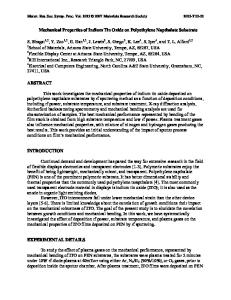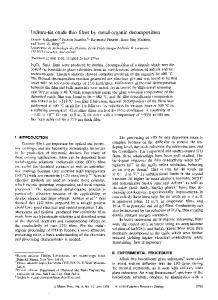Stability of Indium Tin Oxide/Polymer Interfaces
- PDF / 192,201 Bytes
- 12 Pages / 612 x 792 pts (letter) Page_size
- 90 Downloads / 379 Views
V5.5.1
Stability of Indium Tin Oxide/Polymer Interfaces X.Crispin1, A. Crispin1, M. P. de Jong1,2, S. Marciniak1, W. Osikowicz1, S. Jönsson3, M. Fahlman3, Th. Kugler4, L. J. van IJzendoorn2, M. J. A. de Voigt2 and W. R. Salaneck1 1
Department of Physics, IFM, Linköping University, S-58183 Linköping, Sweden.
2
Centre for Plasmaphysics and Radiation Technology, Department of Applied Physics, Eindhoven University of Technology, Eindhoven, The Netherlands. 3
Department of Science and Technology, Campus Norrköping, Linköping University, S60174 Norrköping, Sweden. 4 ACREO AB, Bredgatan 34, S-60221 Norrköping, Sweden. ABSTRACT Interfacial chemistry at indium tin oxide/polymer interfaces is of fundamental importance for the performance of polymer-based light emitting diodes. X-ray photoelectron spectroscopy and Rutherford backscattering spectrometry are used to investigate the stability of the interface formed between indium tin oxide and (i) the light emitting polymer poly(pphenylenevinylene), and (ii) the hole injecting layer poly(3,4-ethylenedioxythiophene) polystyrenesulfonate. The formed interfaces are not stable and indium-containing species diffuse from the metal oxide surface into the polymer layers.
INTRODUCTION Indium tin oxide (ITO) is an important material in the construction of optoelectronic devices. It is one of the few metal oxides that combine technologically interesting properties such as high transparency in the visible range, good electrical conductivity and excellent substrate adherence. In the field of polymer-based light emitting diodes (p-LEDs), the stability of the ITO/polymer interfaces determine to a great extent many of the device properties[1-7]. In this context, the light emitter polymer poly(p-phenylenevinylene) (PPV) and the hole injecting layer poly(3,4-ethylenedioxythiophene) polystyrenesulfonate (PEDTPSS) are susceptible to undergo interfacial chemistry with ITO. One of the first single-layer p-LED used PPV as active emitting layer and ITO as hole-injecting electrode [2]. Un-substituted PPV is insoluble and cannot directly be handled in the p-LEDs design. However, a soluble “precursor-PPV”, the polyelectrolyte poly(pxylylene-α-tetrahydrothiophene chloride, can be spin-coated on ITO surfaces and thermally converted into PPV, either under inert atmosphere or in vacuum. During the conversion, tetrahydrothiophene and HCl are eliminated (Fig. 1).
V5.5.2
Tetrahydrothiophen e
+ S
S
Heat
CH CH
CH CH
treatment H
H
C
Cl
n Sulphonium precursor
n Poly(p-phenylene vinylene) (PPV)
Figure 1. Reaction scheme for the thermal conversion of precursor-PPV to PPV. The released chemical species diffuse through the film. They are either evaporated at the PPV surface or eventually react with the ITO surface. HCl can be involved in chemical reactions with ITO [7], leading to the formation of undesirable chemical species, such as indium chloride [8]. InCl3 is able to p-dope conducting polymers [8c]. The presence of such dopants influences not only the electrical characteristics of the device, b
Data Loading...











